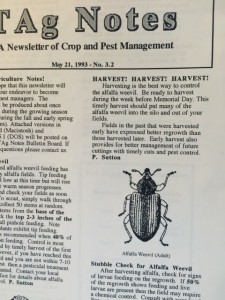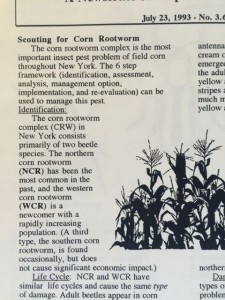The NYS IPM Program turns 30 this year — a great time for a look down memory lane. We were five years old, for instance, when we began our TAg — Tactical Agriculture — teams for field crop producers. Then (and now!), TAg teams across the state met at key times during the cropping season: not in a classroom, not in an office, but in the fields their members farmed. After all, there’s nothing like hands-on experience with real-world problems and successes to learn tested tactics for making the right diagnoses and determine the best way to deal with pest or crop problems under a range of conditions.

Back in 1990, we figured each team would comprise three growers, a couple of agribusiness professionals, and a local Extension educator. Only three growers; really; five participants total if you don’t include the instructors? Yes. We knew that for these adult learners, the small group setting provided the greatest opportunity for in-depth understanding and active, individual participation. Meanwhile, each of those farmers could have scores or hundreds of acres in alfalfa or corn (and now, soybeans). Every decision they made built their competency in both economic and environmental security while contributing to their region’s agricultural well being.
But that first year out of that gate, teams averaged nearly 10 members. Oh — and then there were the “TAg-alongs”: neighboring growers who knew a good thing when they saw it. By now we’ve worked with well over 1,100 growers — growers who make IPM decisions on well over a quarter of a million acres.

Yes, running a TAg team is intensive. Yes, it takes time to do it right. Yes — farmers ask tough questions! And back then we couldn’t shoot members an email if, say, a storm threatened to run amok and we needed to reschedule. We did it all via phone and postcards. Meanwhile, by season’s end, team members were doing things like lending each other equipment or sharing their experience and knowledge outside of class — proving that knowledge is power, that small is beautiful; that — well, that while TAg is old, it’s also new: it’s an endlessly renewable resource. That TAg works. Hats off to TAg on its 25th anniversary.
